AESTHETICIZING MASCULINITY: THE EXAMPLE OF PHYSIQUE PHOTOGRAPHY
by William Stern
The party line on physique photography in the 1950s was that it is thinly-veiled smut, obscenity transparently veneered with arty allusions in a vain quest for legitimacy. While fold-outs of females standing erect in vertiginous stiletto mules, clad in black lace corsets, and topped with jism-line manes of copious hair were not culturally or legally considered obscene, relatively innocuous images of males were banned and confiscated as immoral, perverse, and illicit.
I do not toe this party line. I find these pictures delightful, inspiring and not without aesthetic merit--often of an admittedly camp sort. I enjoy looking at them; I also enjoy taking them. 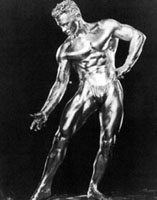 For me, they signify the delight and desire reciprocally invoked by the proud display of well-formed male bodies, which seems to me natural enough, though not particularly interesting for our purposes here. More interesting is how the penetration of a tightly-constructed masculinity by aesthetics serves to excite party-line prejudices.
For me, they signify the delight and desire reciprocally invoked by the proud display of well-formed male bodies, which seems to me natural enough, though not particularly interesting for our purposes here. More interesting is how the penetration of a tightly-constructed masculinity by aesthetics serves to excite party-line prejudices.
The lawsuits, confiscations of printed material (mostly photographic), seizures of assets, fines, jail terms that publishers of physique "manuals" (one was even called MANual) were subjected to by the U.S. government (acting through the Post Office) amounted to persecution. Pretensions to aesthetic value were dismissed as a feeble attempt to clothe the naked male in the artsy aura of the Nude. The short explanation for this is that references to classical art, coupled with male nudity, connote a society that was non-phobic about physical intimacy between men.
Although the U.S. took on the model of Ancient Greece's democratic government, right down to the Corinthian columns that cloak our public buildings--including, of course, post offices--certain significations of this model required censorship. 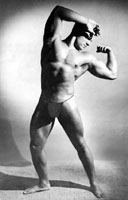 Reminders that the seed of democracy found fertile ground in a society that celebrated and displayed the male body were in such bad taste as to be indecent. That Greece's glory granted kudos to kalos was a perverse circumstance of history that we should be vigilant, vigilantes in fact, to correct, lest history repeat itself.
Reminders that the seed of democracy found fertile ground in a society that celebrated and displayed the male body were in such bad taste as to be indecent. That Greece's glory granted kudos to kalos was a perverse circumstance of history that we should be vigilant, vigilantes in fact, to correct, lest history repeat itself.
This is at least one explanation, to which I cannot subscribe fully because I am reminded of an art historical precedent: the furor over Manet's Olympia, exhibited at the Paris Salon of 1865. Also attacked as pretentious and as bad art, this painting of a naked woman with a classical name, in a pose based on a classical prototype from the revered Renaissance, likewise touched a sensitive nerve. It had nothing to do with homophobia. but it had everything to do with heterosexual prostitution, perceived at the time of the Second Empire as a significant problem in Paris. (Note: Manet's image also drew from popular, "low-brow" prints. The synthesis of high and low styles which underpins some of the resentment against Olympia surfaces again in physique photography.) Parisian prostitution in the Second Empire and American homosexuality in the Fabulous Fifties both posed the body as problem, imaging a crisis in phallic power. 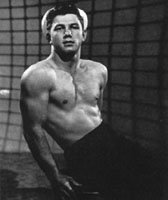 That art could--or worse, should--re-present such a problem is itself problematic. No wonder, then, that the anxiety and anger of a society without solutions was displaced onto the art itself.
That art could--or worse, should--re-present such a problem is itself problematic. No wonder, then, that the anxiety and anger of a society without solutions was displaced onto the art itself.
The self-conscious posing of gym-fit male bodies embodied America's crisis in phallic power after World War II. Queers, male and female, who had enjoyed relative freedom during wartime, were witch-hunted and hounded out of the armed forces. John Dollimore and other queer historians have demonstrated how queers, even--if not especially--those who risked their lives in wartime or aided the war effort in government service, were constructed as a threat to national security in the post-war period. Homosexuality was deliberately conflated with communism to put a paranoid and xenophobic spin on the bad business, giving rise to the offensive epithet, "commie pinko fag."
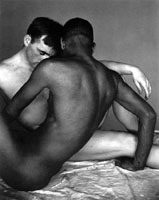 Meanwhile, peacetime polarization of gender roles by government and industry--notably the film industry--made stars of hyper-feminized women (like Doris Day and Jayne Mansfield) and hyper-masculinized men (like Rock Hudson and Marlon Brando). Women were enjoined to vacate the work place and return to the confines of the home, where they could work on their feminine allure, patriotically charming their menfolk into making a baby boom. Displays of near-hysterical femininity proliferated during this period, perhaps as the first step toward replenishing the dwindled supply of nuclear families.
Meanwhile, peacetime polarization of gender roles by government and industry--notably the film industry--made stars of hyper-feminized women (like Doris Day and Jayne Mansfield) and hyper-masculinized men (like Rock Hudson and Marlon Brando). Women were enjoined to vacate the work place and return to the confines of the home, where they could work on their feminine allure, patriotically charming their menfolk into making a baby boom. Displays of near-hysterical femininity proliferated during this period, perhaps as the first step toward replenishing the dwindled supply of nuclear families.
The art of physique photography also boomed in the 1950s, and while the muscle men depicted often exhibited the hyper-masculinity so de rigeur in a sissy-fearing society, they did so in a perverse way: implicitly critiquing the legitimation of certain forms of display (i.e., the sexualized and commodified female form). The explicit display of the male in good form was considered very bad form indeed.
Part and parcel of the Post Office prosecution of such imagery was as an insistence on its lack of artistic merit, a counter-attack against the publishers' insistence that physique photos were by and for artists. Manifestos that clearly state this intent as well as attempts by physique-photo publishers to ally themselves with a classical past, frequently accompanied photo spreads (e.g., Grecian Guild). Only recently has the art world's critical establishment begun to acknowledge such claims through shows of work by the more famous (and better-selling) among these artist/photographers, such as George Platt Lynes (at right) and Bruce of L.A.
The belated attention of art historians is not suprising in view of the fact that these photos erase the denial that brought formalist art historical discourse into being in the first place. 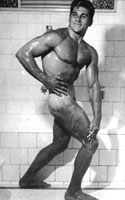 Formalism's radical evacuation of content is what allowed art history to harbor homoerotic desire, creating a closet discourse that enabled papers and presentations on, for example, the luscious derri¸res of Greek ephebes. By the early 1950s, the modernist avant-garde had appropriated this formalist evacuation of content, originally designed for and by queers like Johann Winckelmann (the father of art history), to an aggressive and macho denial that homoerotic content ever existed at all. In onanistic acts of "creation," action painters, as they were called, eschewed the figural tradition of Western art that was based on the classical and Renaissance focus on the body. Jackson Pollack, for instance, wielded a stick rather than a brush, to drip onto a horizontal canvas.
Formalism's radical evacuation of content is what allowed art history to harbor homoerotic desire, creating a closet discourse that enabled papers and presentations on, for example, the luscious derri¸res of Greek ephebes. By the early 1950s, the modernist avant-garde had appropriated this formalist evacuation of content, originally designed for and by queers like Johann Winckelmann (the father of art history), to an aggressive and macho denial that homoerotic content ever existed at all. In onanistic acts of "creation," action painters, as they were called, eschewed the figural tradition of Western art that was based on the classical and Renaissance focus on the body. Jackson Pollack, for instance, wielded a stick rather than a brush, to drip onto a horizontal canvas.
The masturbatory implications of this were derided by contemporary critics, who claimed that "action painting" was as self-indulgent as it was personal, leaving the public out of the picture. The more pompous critics, however, gave action painting the glorious title of Abstract Expressionism and championed the painter's process as spiritual rather than sexual, calling it a heroic quest for transcendence. This is the view that art history teaches us today.
To reconcile these two seemingly opposed views, one might offer the following synthesis: these artists transcended both the female sex and homoeroticism, arriving at a nirvana of pure narcissism--the autoerotic. But whether one chooses to view these so-called avant-gardists as sublimely heroic or as self-absorbed white guys jerking themselves off, their action--painting--stands in contradistinction to the photos of beefcake, which remove the action--be it spiritual or sexual--to the realm of the beholder.
By the 1960s the deconstructive work of Jasper Johns, Robert Rauschenberg, Cy Twombly, and Andy Warhol (all of whom are coincidentally gay) parodied or probed the limitations of abstract expressionism's macho-man questings via subtle queerings. Dare I ask, is it not unlikely that these gay artists found physique photography more uplifting than, say, deKooning's canvases of women? In any event, I venture to say that sexual and spiritual ecstasy/frenzy overlap in ways that could just as well be illustrated by the work of the freak physique photographers, who were and remain the true martyrs, as by the work of canonized artists like deKooning or Pollock.
By the 1970s, gay liberation (as it was optimistically termed) opened up the closet--a closet that capitalists, hip to an emerging gay market, could barely wait to fill up with all sorts of goodies, particularly clothes. 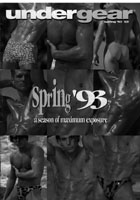 The strategy was and still is to map all the commodity and sexual fetishizing of women's bodies onto men's bodies. It is now perfectly acceptable to show male bodies in the same fragmented and objectified way as women's, which had always worked so well to sell--which means to sell out--the American dream.
The strategy was and still is to map all the commodity and sexual fetishizing of women's bodies onto men's bodies. It is now perfectly acceptable to show male bodies in the same fragmented and objectified way as women's, which had always worked so well to sell--which means to sell out--the American dream.
However, the 1980s ushered in a new crisis of phallic power, which came to be represented by and displaced onto the work of Robert Mapplethorpe. I refer to the dilemma of selling sex during a deadly epidemic which can be sexually transmitted. Like the Second Empire bourgeoisie, who insisted on virgins and frequented prostitutes, or McCarthy-era Americans, who hailed manhood and hated man-love, today's purveyors of sexy products (which, according to advertisers, includes everything from chewing gum to monster trucks) want it both ways.
Robert Mapplethorpe not only evoked the spectre of AIDS in his work but had the cheek to die publicly of this unspeakable plague (at least unspeakable at the time of the Reagan Administration) just as his exhibition began its circuitous route across the country via courts and controversy. Mapplethorpe's work clearly picks up on physique photography and its attendant classicism, which he updates and amplifies through considerations of race and gender. While often erotic, Mapplethorpe's photos are not voyeuristic. One senses the agency of the sitters, who present themselves in a manner complicit with the photographer. Mapplethorpe works in a tradition which depicts the body as a whole rather than fragmenting it into replacement parts of an immortal replicant.
In America, it was the nineteenth-century artist Thomas Eakins, director of the country's premier art academy, who first depicted the body as mortality made flesh: a real, vulnerable, and (perhaps dangerously) knowable whole. For this he was ousted from the Academy and outcast from society. The legacy of his vision survived--not in academic "high art" but in the popular form of physique photography, which emerged at the turn of the century and thrived until the 1950s. when attempts were made to halt its proliferation. Not until a full century after Eakin's dismissal, with the work of Robert Mapplethorpe showing the way, have these visions of beauty returned to the realm of fine arts.

